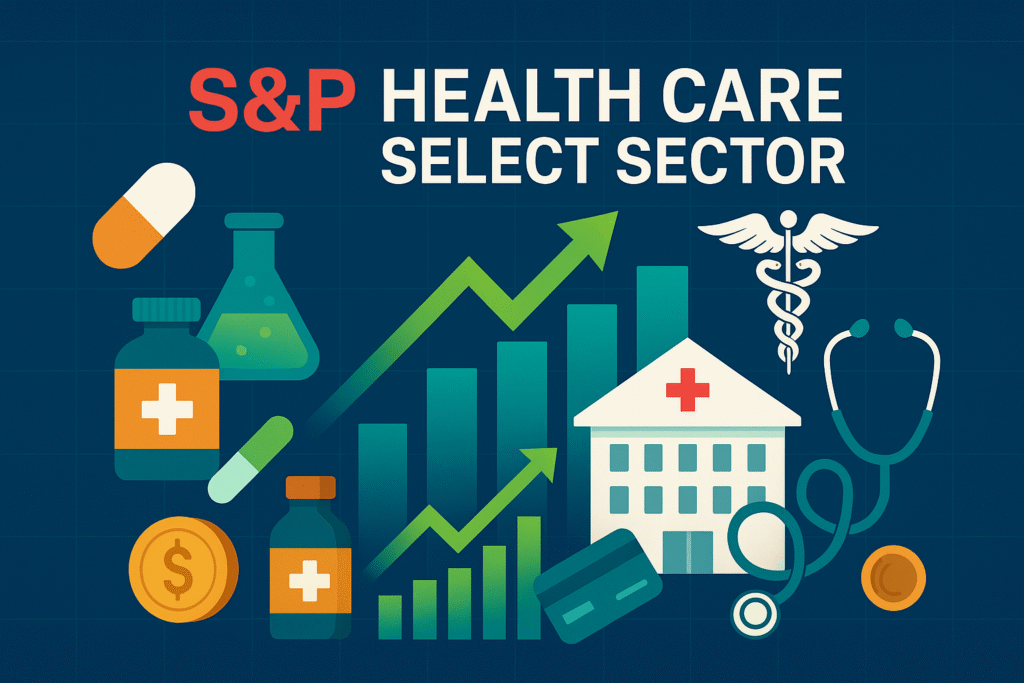Tracks the health-care constituents of the S&P 500—pharmaceuticals, biotech, medical devices and managed-care firms—therefore giving investors a concentrated, large-cap view of America’s most defensive growth industry.

1. Why This Index Exists
To begin with, the S&P Dow Jones index family carves the S&P 500 into eleven “Select Sector” slices. As a result, the Health Care Select Sector Index (ticker IXV) lets traders overweight or underweight health-care stocks without touching technology, energy or banks.
2. Construction Rules — Fast Facts
| Rule | Detail |
|---|---|
| Parent Universe | All S&P 500 members with a GICS Health Care sector code |
| Weighting | Free-float market cap; no formal cap, yet quarterly reviews limit outsized drifts |
| Rebalance Cadence | Quarterly (March |
| Dividend Treatment | Price index omits payouts; total-return version (IXVTR) reinvests them |
Consequently, mega-caps steer performance, while quarterly resets add or delete stocks that migrate in or out of the S&P 500.
3. Snapshot (May 2025)
| Metric | Value |
|---|---|
| Constituents | 66 |
| Index Level | 1 640 (price) |
| Float-Adj. Market Cap | US $7.0 trillion |
| Dividend Yield | 1.6 % |
| Top Holdings | Eli Lilly 9.1 %, UnitedHealth 8.9 %, Johnson & Johnson 7.7 %, Merck 4.3 %, AbbVie 4.1 % |
| Sub-Industry Split* | Pharma 46 %, Med-Tech 27 %, Managed Care 13 %, Biotech 9 %, Life-Science Tools 5 % |
*Weights post-March 2025 rebalance.
4. Recent Performance (Total Return, USD)
| Year | Index | S&P 500 | Main Driver |
|---|---|---|---|
| 2022 | –3.0 % | –18.1 % | Defensive rotation cushioned fall |
| 2023 | +21.4 % | +24.2 % | GLP-1 and AI-enabled diagnostics |
| 2024 | +12.3 % | +14.3 % | Robust earnings, M&A rebound |
| YTD 2025 | +6.2 % | +6.8 % | Oncology data wins offset rate fears |
Thus, the three-year annualised volatility stands near 14 %, noticeably lower than the broad market.
5. How Investors Use It
- Targeted Beta: ETFs such as XLV replicate IXV, allowing instant health-care exposure in one trade.
- Sector Rotation: Macro desks overweight during recessions and trim in early-cycle rallies.
- Benchmarking: Active U.S. health-care funds measure alpha relative to this index.
- Options & Futures: Cboe options on XLV provide tactical hedging against policy-driven price swings.
6. Strengths & Caveats
| Strengths | Caveats |
|---|---|
| Pure U.S. large-cap health-care exposure | Mega-cap concentration: top 5 ≈ 34 % weight |
| Low correlation to cyclical sectors | Patent cliffs and policy reform can cause sector-wide drawdowns |
| Deep ETF & derivatives liquidity | Omits small-cap biotechs—innovation beta may be muted |
| Quarterly reviews keep roster current | U.S.–only; no European or Japanese pharma diversification |
7. Themes to Watch
- Obesity Drugs: GLP-1 demand could push Eli Lilly and Novo-Nordisk ADR (if added) toward 10 % cap.
- AI Diagnostics: Med-tech firms integrating imaging AI may climb index ranks at the next rebalance.
- Medicare Reform: Pricing negotiations under the Inflation Reduction Act could pressure margins, yet diversified portfolios dampen single-drug impact.
- M&A Revival: Cash-rich mega-caps eye mid-cap biotechs; post-deal weight changes will appear in quarterly rebalances.
Key Takeaways
The S&P Health Care Select Sector Index distills the S&P 500’s health-care names into a free-float-weighted gauge. With 66 constituents, a 1.6 % yield and lower volatility than the overall market, IXV/XLV remains the go-to tool for investors seeking defensive growth, dividend income and innovation exposure—all while tracking U.S. policy and demographic trends.